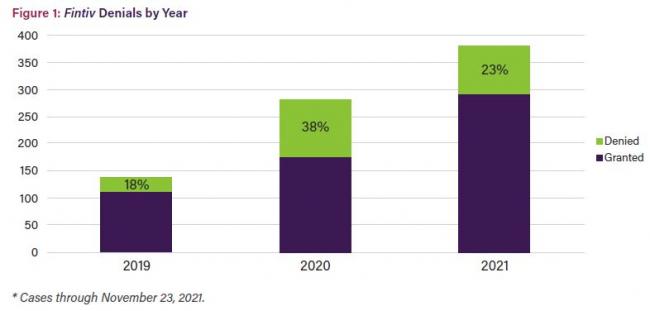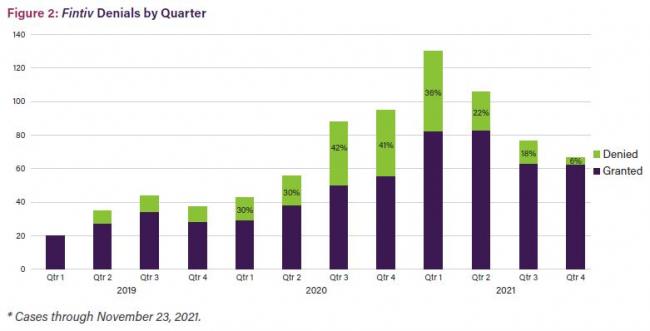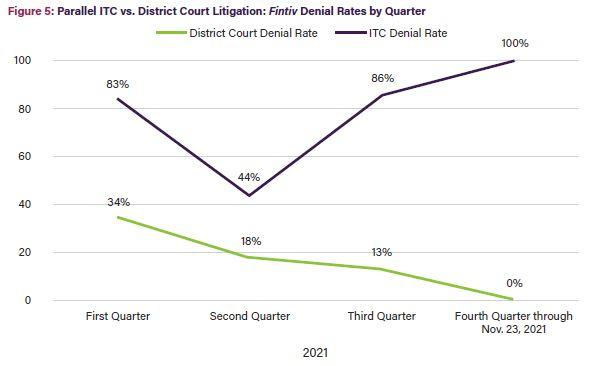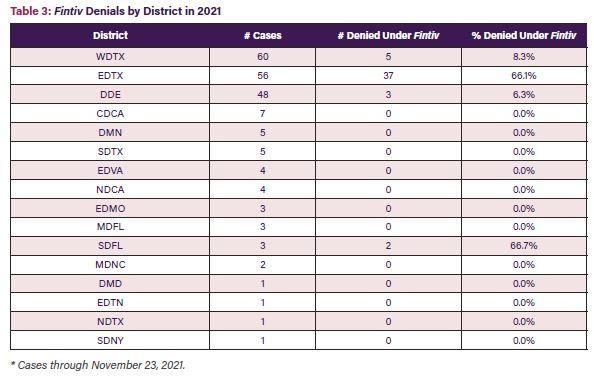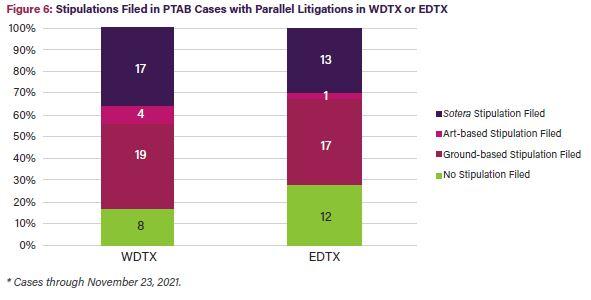In 2021, Fintiv1 continued to be one of the hottest and most controversial issues facing the patent bar.2 The USPTO Patent Trial and Appeal Board’s (PTAB) precedential Fintiv decision enumerated factors that the PTAB applies when evaluating whether to exercise its discretion to deny instituting an inter partes review (IPR) or post-grant review (PGR) in light of parallel district court or US International Trade Commission (ITC) litigation involving the same patent.3 Because Fintiv can deprive parties—who file otherwise meritorious petitions—of review, some stakeholders criticize Fintiv as contrary to the Congressional intent of the America Invents Act (AIA) and seek to defang or eliminate Fintiv altogether. Others argue that Fintiv is rooted in sound policy that avoids duplicative and expensive litigation and increases the value of patents. Regardless of where one stands, Fintiv remains a key issue that must be analyzed by any party faced with the prospect of parallel patent litigation at the PTAB and any other trial tribunal.
Analyzing over 400 PTAB decisions, this article presents a data-driven analysis of the following key developments that emerged in 2021 with respect to the PTAB’s evaluation and application of the Fintiv framework:
- Petitioner Stipulations: Following the PTAB’s informative Sand Revolution II4 and precedential Sotera5 decisions, petitioners have been advancing stipulations that agree to forgo presenting certain invalidity challenges in parallel litigation if the PTAB institutes review. These stipulations vary in scope, and this article categorizes the various flavors of stipulation—from narrowest to broadest—and evaluates their efficacies. Unsurprisingly, advancing the broadest stipulation was most likely to favorably impact the Fintiv analysis for petitioners. But our findings on art-and ground-based stipulations may surprise you.
- ITC vs. District Court: One of the more controversial applications of Fintiv is when the PTAB denies AIA review based on parallel litigation at the ITC. Nevertheless, our data indicate that Fintiv denials based on parallel ITC litigation had a strong year in 2021. In fact, our findings indicate that ITC-based denials are on the rise while district court-based denials have fallen precipitously.
- Denials By District: In 2021, was the PTAB more likely to deny AIA review over parallel litigation in the Eastern or Western District of Texas? We reveal the answer below and explain some factors that may be driving our results. Spoiler alert: EDTX.
Before diving into these issues, we provide a brief background on Fintiv and general statistics on Fintiv denials.
Background and Lay of the Land
35 U.S.C. §§ 314(a) and 324(a) grant the Director of the US Patent and Trademark Office (USPTO) discretion to deny instituting an AIA trial. As explained in the PTAB’s Trial Practice Guide, the PTAB interprets these statutes as permitting denial in light of “events in other proceedings related to the same patent, either at the Office, in district courts, or the ITC.”6 In Fintiv, the PTAB enumerated six non-exhaustive factors weighed by the PTAB when determining whether to exercise this discretion in view of parallel litigation: (1) whether the court granted a stay or evidence exists that one may be granted if a proceeding is instituted; (2) proximity of the court’s trial date to the PTAB’s projected statutory deadline for a final written decision; (3) investment in the parallel proceeding by the court and the parties; (4) overlap between issues raised in the petition and in the parallel proceeding; (5) whether the petitioner and the defendant in the parallel proceeding are the same party; and (6) other circumstances that impact the PTAB’s exercise of discretion, including the merits.7
Following Fintiv’s precedential designation in May 2020, parties saw a spike in Fintiv-based discretionary denials. At first a boon to patent owners, such denials fell significantly over the course of 2021 as an important new tool—the stipulation—became available and more widely used and understood by petitioners. In 2021, the PTAB also scrutinized trial dates of parallel cases more closely, shifting away from its prior approach of taking them at face value. Indeed, the PTAB often recognized that the facts surrounding parallel litigations are fluid, and even reversed some institution decisions when circumstances changed in parallel cases.8
The analysis in Figure 1 considered cases in which the PTAB evaluated the Fintiv factors. It does not include decisions that mention Fintiv but denied review for other reasons, such as the merits. Overall, the results show a lower rate of Fintiv-based denials in 2021 (23%) compared to 2020 (38%). Nevertheless, the statistics also show that Fintiv has become a routine part of the PTAB’s and parties’ analyses, with the PTAB addressing the Fintiv factors in almost 400 cases this year, significantly more than in previous years. The institution rate for cases in which the Fintiv factors were evaluated in 2021 (77%) is also significantly higher than the PTAB’s overall institution rate for 2021 (59%).9 One reason for this result may be that, when Fintiv is in play, patent owners may focus their preliminary responses more on discretionary denial arguments than on rebutting the grounds of unpatentability.
Breaking these cases down by quarter (see Figure 2), the PTAB’s denial rate peaked in the second half of 2020, which aligns with Fintiv’s precedential designation in May 2020. A decline is then seen in each subsequent quarter of 2021.
A number of factors—including the rise of petitioner stipulations; uncertainty of district court trial dates caused by the COVID pandemic, court congestion, and venue challenges; and public criticism of Fintiv—likely contributed to 2021’s fall in Fintiv-based denials. The sections below address issues that have influenced the PTAB’s discretionary denial analysis in 2021, as well as those that may influence the PTAB’s analysis in the coming year.
Petitioner Stipulations
One of the policy considerations undergirding Fintiv is reducing or eliminating duplicative litigation. The fourth Fintiv factor reflects this consideration, requiring an evaluation of the amount of overlap between the invalidity issues raised in the petition and in the parallel proceeding. Factor four weighs in favor of denial when the invalidity issues overlap and against denial when they do not.10
Seeking to mitigate concerns over duplicative litigation, petitioners have been filing stipulations that agree to forgo raising certain invalidity challenges in parallel proceedings. These stipulations fall into three general categories. From narrowest to broadest, they are: (1) ground-based stipulations, (2) art-based stipulations, and (3) stipulations tracking the “raised or reasonably could have raised” language of the estoppel provisions in 35 U.S.C. §§ 315(e) and 325(e), which we refer to as Sotera stipulations.11
The PTAB’s informative Sand Revolution II decision illustrates the narrowest, ground-based stipulation. There, the petitioner stipulated that “if the IPR is instituted, Petitioner will not pursue the same grounds in the district court litigation.”12 The PTAB found this “mitigates to some degree the concerns of duplicative efforts between the district court and the Board, as well as concerns of potentially conflicting decisions”13 and, consequently, that factor four “weigh[ed] marginally in favor of not exercising discretion to deny institution.”14
Art-based stipulations are broader, agreeing not to pursue invalidity challenges in the parallel litigation based on any of the prior art used in the petition. ByteDance Ltd. v. Triller, Inc., IPR2021-00099, is illustrative.15 There, the petitioner stipulated, in the event of institution, it would not rely on any of the IPR references in the parallel litigation.16 The PTAB ultimately granted institution based, in part, on a finding that “[b]ecause Petitioner’s stipulation is broader than that offered in Sand Revolution II but narrower than that of Sotera, [factor four weighed] somewhat in favor of not exercising discretion to deny institution.”17
On the other end of the spectrum, the PTAB’s precedential Sotera decision illustrates the broadest stipulation, which tracks the language of the estoppel provisions in 35 U.S.C. § 315(e). In Sotera, the petitioner stipulated it “will not pursue in the District Court Litigation any ground raised or that could have been reasonably raised in an IPR.”18 The PTAB concluded that “Petitioner’s stipulation here mitigates any concerns of duplicative efforts between the district court and the Board, as well as concerns of potentially conflicting decisions.”19 Therefore, the PTAB found that Fintiv factor four “weighs strongly in favor of not exercising discretion to deny institution.”20
Against this backdrop, we analyzed PTAB decisions from 2021 to understand the influence of various stipulations on the Fintiv analysis. As for our methodology, we first retrieved all cases in which the PTAB analyzed the Fintiv factors, removing cases where Fintiv was mentioned but not evaluated. Next, we identified the PTAB’s determination of (a) whether Fintiv factor four weighed in favor or against institution, or was neutral21; and (b) whether the overall Fintiv analysis weighed in favor or against institution. When a rehearing request had been decided, we used the results from the rehearing decision instead of the original institution decision.
We then reviewed each case for the type of stipulation filed by Petitioner, if any. We allocated the cases into the three categories mentioned above, as well as a fourth category denoting where no stipulation was filed. Any cases that did not squarely fall into one of these four categories were omitted from our statistics. We did not remove cases in which stipulations were specific only to the claims at issue in the IPR; in most cases, this did not significantly affect the overlap of issues between proceedings. The results of our analysis are shown in Table 1 above.
Unsurprisingly, the results show that the broader the stipulation, the less likely it is that the PTAB will deny under Fintiv. Less than 5% of cases where the petitioner advanced the broadest, Sotera stipulation were denied under Fintiv. The results also show a strong correlation between the two broadest stipulations (Sotera and art-based) and the ultimate Fintiv outcome.
The results related to the art- and ground-based stipulations proved somewhat more surprising. Art-based stipulations allow the petitioner/defendant to continue to assert in the parallel litigation any prior art that could have been (but was not) raised before the PTAB—a significant advantage over Sotera stipulations. Yet the PTAB’s treatment of art-based stipulations was nearly on par with that of Sotera stipulations, resulting in only slightly higher risk of (i) the PTAB weighing factor four in favor of denial and (ii) denying institution: less than a 5 percentage point difference for both metrics. From a risk/reward standpoint, art-based stipulations appear to be the best choice for petitioners who consider offering a stipulation to bolster their chances of winning at institution. On the flip side, patent owners should pay close attention to these statistics when developing their strategy for responding to a petition. Faced with a broad Sotera or art-based stipulation, a patent owner may opt to devote more resources to other arguments against institution. Even so, a patent owner should still evaluate whether the proffered stipulation truly eliminates overlap between the proceedings. For example, IPR challenges are limited to using patents and printed publications; product prior art cannot be used.22 Patent owners should evaluate whether the IPR prior art is cumulative with any product prior art asserted in parallel litigation.
The results related to ground-based stipulations were also interesting. As expected, compared to art-based stipulations, a higher percentage of decisions considering ground-based stipulations found that factor four favored denial and ultimately denied institution under Fintiv. Compared to no stipulation, ground-based stipulations significantly increased the petitioner’s chances of mitigating the PTAB’s concerns regarding factor four, but only appear to have a small impact on the ultimate Fintiv outcome. Our data indicate that advancing a ground-based stipulation only marginally increased a petitioner’s ability to avoid a Fintiv denial.
Of course, stipulations do not tell the whole story for any given proceeding. All facts need to be considered. For instance, if a patent is asserted in multiple co-pending litigations, or there are multiple defendants in the parallel litigation, even a Sotera stipulation may not be enough to avoid denial. In Cisco Systems, Inc. v. Estech Sys., Inc., IPR2021-00332, for instance, the petitioner advanced a Sotera stipulation.23 The parallel litigation, however, included six other defendants, and thus the patent owner argued that the petitioner “would be free to continue pursuing the same unpatentability arguments” in district court through the other defendants.24 The petitioner proceeded to file additional stipulations on behalf of the other defendants, which the PTAB found mitigated any concerns raised by overlapping issues.25 Nevertheless, the PTAB still denied institution based on an early trial date and significant investment in the parallel litigation—a rare instance where the Sotera stipulation did not carry the day.26
At bottom, petitioners and patent owners need to care-fully analyze all facts surrounding potential overlap between the PTAB and parallel litigation. But under-standing the impact of the various flavors of stipulation helps both sides evaluate their respective likelihood of success under Fintiv. Petitioners can gain a significant advantage at the PTAB by filing a broad stipulation at the expense of limiting their invalidity defenses in the parallel litigation. Such a broad stipulation may be beneficial to petitioners when the prior art presents nuanced technical issues better understood by PTAB judges than by juries, or to take advantage of the lower preponderance of the evidence standard at the PTAB compared with the clear and convincing evidentiary standard in district court. On the other hand, patent owners should analyze the stipulation language and associated facts to determine whether a petitioner’s stipulation actually reduces overlap. More often than not, an argument can be made that similar issues will still arise in the parallel litigation due to similar available prior art, multiple defendants or co-pending litigations, or other factors.
Treatment of District Court vs. ITC Proceedings
The Fintiv analysis takes into account parallel litigations in both district court and at the ITC.27Fintiv explained that “even though the Office and the district court would not be bound by the ITC’s decision, an earlier ITC trial date may favor exercising authority to deny institution under [Fintiv] if the ITC is going to decide the same or substantially similar issues to those presented in the petition.”28 Since the ITC cannot invalidate a patent and district court cases are often stayed pending resolution of ITC investigations, we were interested to see how the PTAB treated patents involved in ITC investigations compared to those only involved in parallel district court proceedings.
To gather statistics, we retrieved all cases from 2021 in which the PTAB analyzed the Fintiv factors, removing cases where Fintiv was mentioned but not evaluated. For each case, we determined whether the patent was also involved in an ITC proceeding. If so, the case was categorized as an “ITC” case. The remaining cases—those with patents not involved in ITC proceedings—were categorized as having only parallel district court proceedings. Any case denied for reasons other than Fintiv (e.g., based on deficient merits) was omitted from our statistics.
The results are rather striking (see Table 2 above). When considering parallel ITC investigations, the PTAB denied institution in favor of the parallel litigation about three quarters of the time. In contrast, when considering parallel district court proceedings, the PTAB denied institution in favor of the parallel litigation less than 20% of the time.
The results assessed on a quarterly basis in Figure 5 also show that the PTAB has continued to deny institu-tion in favor of parallel ITC proceedings, while denials in favor of parallel district court proceedings have diminished significantly. Indeed, our results show that the de-nial rates for cases involving only parallel district court proceedings has decreased significantly each quarter in 2021 to almost zero while denial rates for cases having parallel ITC litigation recently increased.
The difference in denial rates may be attributed to the typically more aggressive and more certain schedules of ITC investigation. In Nintendo Co., Ltd. v. GameVice, Inc., IPR2020-01197, for example, an IPR petition was filed less than two months after institution of the ITC in-vestigation.29 Yet the PTAB denied institution based on significant investment in the ITC investigation at the time of the institution decision and a final ITC determination scheduled almost six months before the PTAB’s expected final written decision.30 Patent Owners should keep these denial rates in mind when considering whether to raise Fintiv arguments, and when considering how much space or effort to devote to such arguments. A pending ITC investigation can greatly increase patent owners’ chances of avoiding institution, whereas a pending district court case may no longer have the same impact.
Petitioners should also consider whether a PGR or IPR petition is cost-effective when an ITC trial will occur be-fore the PTAB issues the final written decision. In such a case, a broad stipulation that eliminates any overlap-ping invalidity issues may be necessary to persuade the PTAB to institute. In SharkNinja Operating LLC v. iRobot Corp., IPR2021-00545, for example, the PTAB instituted review even though a parallel ITC investigation was scheduled to be completed before the final written decision, and a motion to stay the ITC investigation had al-ready been denied.31 The petitioner, however, filed its petition only one day after the ITC initiated its investigation, and broadly stipulated that “it [would] not pursue any grounds that were raised or reasonably could have been raised in this IPR against the ’511 patent in the ITC investigation or in district court.”32 The PTAB therefore stated: “In weighing the totality of the evidence, Petitioner’s diligence in promptly filing the Petition and stipulation to avoid duplication both persuade us not to exercise discretion under § 314(a) to deny institution.”33 This decision highlights that, for both parties, timing and preparation is key to navigating parallel litigation.
Treatment of Different Districts
Fintiv factors one and two consider the likelihood of a stay being granted in the parallel litigation and the proximity of the court’s trial date to the PTAB’s projected final written decision deadline. Although the PTAB stated in Fintiv that it “generally take[s] courts’ trial schedules at face value absent some strong evidence to the con-trary,”34 the PTAB has since recognized the uncertainty of district court case schedules, including scheduled trial dates, especially in the wake of the COVID-19 pandemic.35
Interestingly, our results indicate that the PTAB has treated certain districts differently when evaluating the expected course of a proceeding. For our analysis, we again retrieved all cases from 2021 in which the PTAB analyzed the Fintiv factors. For each patent involved in the retrieved cases, we searched the districts in which the patent had been asserted. Cases involving patents asserted in multiple districts, or transferred from one district to another, were omitted. By isolating PTAB cases with a parallel litigation in only one district, we ensure that the PTAB’s decision is correlated to that district. Any case that was denied for reasons other than Fintiv (e.g., based on deficient merits) was omitted from our statistics. The results are shown in Table 3. We note, however, that we identified more than 100 cases involving patents asserted in multiple districts, and the PTAB has applied Fintiv to deny institution based on co-pending litigation that the petitioner was not involved in (e.g., litigation be-tween the patent owner and a third party in a different district).36
The vast majority of patents were involved in litigations in the Western District of Texas (WDTX), Eastern District of Texas (EDTX), and District of Delaware (DDE), three venues commonly selected by plaintiffs. But the denial rate for patents asserted in the Eastern District of Texas remains far greater than that of the other two venues.
The Eastern and Western Districts of Texas are both considered “rocket dockets.” From that fact alone, we would expect the denial rates to be much closer. However, the differences between the Eastern and Western Districts of Texas show that the PTAB has applied more scrutiny in 2021 to the specific facts of each case.
Based on our results, part of the disparity between Eastern and Western Districts of Texas may be attributed to petitioner filed stipulations. We cross-referenced our district court data with our stipulation data to determine what types of stipulations were filed in the cases with parallel litigations in the Eastern and Western Districts of Texas (see Figure 6). We found for parallel proceedings in the Western District of Texas, the petitioner filed a broad stipulation in approximately 44% the cases, either stipulating to full estoppel, as in Sotera, or not to use the same art in the parallel litigation. By contrast, for parallel proceedings in the Eastern District, the petitioner filed such broad stipulations only about 30% of the time.
The numbers here, however, are not so extreme as to account for the large difference in denial rates. Instead, we speculate the PTAB has been treating trial dates in the Western District of Texas as less certain than the Eastern District. A number of factors may be at play, including that the Eastern District has a much longer history and track record of patent litigation and the well documented venue transfer issues playing out in the Western District. For example, the possibility of venue transfer from a “rocket docket” district (such as the Western District) to another district that builds more time into its schedule, and thus would set a later trial date, may affect the PTAB’s analysis of Fintiv factor 2.37 Court congestion and delays due to COVID are also likely factoring into the PTAB’s decisions.
As for the District of Delaware, the slower pace of cases likely contributes considerably to the PTAB’s analysis. In the few cases that were denied, the petitioner waited until days prior to its statutory deadline to file the petition.38 The trial date was set to occur more than six months prior to the PTAB’s final written decision, and the petitioner filed only a narrow stipulation not to pursue the same invalidity grounds in district court.39
Overall, both petitioners and patent owners should con-sider the location of the parallel district court proceeding in their planning. For cases pending in the Eastern District of Texas, petitioners will benefit greatly by diligently filing their petition, minimizing the chance that trial in the district court will occur before the PTAB’s final written decision. In the Western District of Texas, petitioners may have more leeway on timing if coupled with broad stipulations that reduce overlap between the PTAB and district court.
All the data and all the ink related to Fintiv over the past year demonstrate that it had a significant impact on patent litigation across all tribunals in 2021. 2022 will likely be another very active year because, while PTAB denials based on Fintiv decreased in 2021, the number of cases addressing Fintiv (and thus parties arguing for and against Fintiv denial) increased. Plus, with a new Director likely at the helm of the PTO, various challenges to Fintiv playing out in the courts, and proposed legislation40 to rein in the PTAB’s discretion at institution, it remains to be seen whether Fintiv will survive another year. Check back in with us this time next year to find out.
1Apple Inc. v. Fintiv, Inc., IPR2020-00019, Paper 11 (P.T.A.B. Mar. 20, 2020)
(precedential).
2 This article analyzes cases decided in the 2021 calendar year.
3Fintiv, Paper 11 at 6.
4 Sand Revolution II, LLC v. Continental Intermodal Group-Trucking LLC, IPR2019-01393, Paper 24 (P.T.A.B. June 16, 2020) (informative).
5Sotera Wireless, Inc., v. Masimo Corp., IPR2020-01019, Paper 12 at 18 (P.T.A.B. Dec. 1, 2020) (precedential as to § II.A).
6 November 2019 Consolidated Trial Practice Guide (“TPG”), 58.
7Fintiv, Paper 11 at 6.
8See, e.g., Canadian Solar Inc. v. The Solaria Corp., IPR2021-00095, Paper 17 (P.T.A.B. Sept. 24, 2021) (reversing denial of institution because the challenged patent was removed from the parallel litigation); SharkNinja Operating LLC v. iRobot Corp., IPR2021-00544, Paper 13 (P.T.A.B. Nov. 17, 2021) (reversing denial of institution based, in part, on a “stipulati[on] to accept full []estoppel upon institution”); Phillip Morris Prods., S.A. v. RAI Strategic Holdings, Inc., IPR2020-00921, Paper 13 (P.T.A.B. Aug. 5, 2021) (reversing denial of institution due to a stay of the parallel district court litigation.
9 PTAB Trial Statistics FY21 at p. 6 (available at https://www.uspto.gov/sites/default/files/documents/ptab_aia_fy2021__roundup.pdf). Note that the PT-AB’s published results pertain to fiscal year 2021 (Oct. 1, 2020 to Sep. 30, 2021).
10Fintiv, Paper 11 at 12–13.
11 35 U.S.C. § 315(e) states that upon a final written decision pertaining to a claim in a patent, a petitioner may not assert—in any of (1) another proceed-ing before the Patent Office, (2) a civil action arising in whole or in part under section 1338 of title 28, or (3) a proceeding before the International Trade Commission—“that the claim is invalid on any ground that the petitioner raised or reasonably could have raised during that inter partes review.” 35 U.S.C. § 325(e) applies to post grant review and has similar language.
12Sand Revolution II, Paper 24 at 11–12 (citing id., Paper 22 at 7; Exhibit 1015).
13Id. at 12.
14Id. at 12.
15ByteDance, Ltd. v. Triller, Inc., IPR2021-00099, Paper 8 (P.T.A.B. Apr. 21, 2021).
16Id. at 12–13.
17Id. at 12–13, 15–16.
18 Sotera, Paper 12 at 18.
19Id. at 19.
20Id.
21 Of note, the Board found factor 4 neutral in only 11 cases. In every one of these cases, no stipulation was filed, and the Board generally found the factor neutral due to related factors. See, e.g., London Luxury LLC v. E & E Co., Ltd., PGR2021-000083, Paper 10 at 12 (P.T.A.B. Nov. 15, 2021) (finding Fintiv factor 4 neutral due to lack of a scheduled trial date, even though there was “complete overlap between the issues and parties between the district court case and [the PTAB] proceeding.”)
22 35 U.S.C. § 311(b)
23Cisco Systems, Inc. v. Estech Sys., Inc., IPR2021-00332, Paper 11 at 11 (P.T.A.B. July 7, 2021).
24Id.
25Id.
26Id. at 12, 14.
27See Fintiv, Paper 11 at 8–9; TPG at 58.
28Id. at 8.
29Nintendo Co., Ltd. v. GameVice, Inc., IPR2020-01197, Paper 13 at 15 (P.T.A.B. Jan. 12, 2021).
30Id. at 12–15, 22–23.
31SharkNinja Operating LLC v. iRobot Corp., IPR2021-00545, Paper 11 at 6–10 (P.T.A.B. Sept. 8, 2021).
32 Id. at 7–9.
33Id. at 9–10.
34 Apple Inc. v. Fintiv, Inc., IPR2020-00019, Paper 15 at 12–13 (P.T.A.B. May 13, 2020) (informative).
35 Apple Inc. v. Parus Holdings, Inc., IPR2020-00686, Paper 9 at 13 (P.T.A.B. Sep. 23, 2020).
36See Mylan Lab’ys Ltd. v. Janssen Pharmaceutica, N.V., 989 F.3d 1375 (Fed. Cir. 2021), cert. denied, — S. Ct. — 2022 WL 145242 (Jan. 18, 2022).
37See, e.g., Dish Network L.L.C. v. Broadband iTV, Inc., IPR2020-01267, Paper 15 at 17 (P.T.A.B. Jan. 21, 2021).
38TA Instruments-Waters LLC v. Malvern Panalytical Inc., IPR2021-00210, Paper 9 (P.T.A.B. May 27, 2021); TA Instruments-Waters LLC v. Malvern Panalytical Inc., IPR2021-00211, Paper 8 (P.T.A.B. May 27, 2021); TA Instruments-Waters LLC v. Malvern Panalytical Inc., IPR2021-00213, Paper 8 (P.T.A.B. May 27, 2021).
39TA Instruments-Waters LLC v. Malvern Panalytical Inc., IPR2021-00210, Paper 9 at 10–17 (P.T.A.B. May 27, 2021).
40See, e.g., https://www.law360.com/articles/1426894/more-than-fintiv-what-to-know-about-the-ptab-revision-bill; https://www.ipwatchdog. com/2021/09/23/looming-leahy-bill-end-fintiv-practice-ptab/id=138020/.
This article appeared in the 2021 PTAB Year in Review: Analysis & Trends report. To view our graphs on Data and Trends, please click here.

Receive insights from the most respected practitioners of IP law, straight to your inbox.
Subscribe for Updates
